Conversations
Mark Wallinger and Donna De Salvo on ‘Study for Self Reflection’

Installation view, ‘Mark Wallinger. Study for Self Reflection,’ Hauser & Wirth New York, 22nd Street, 2018
On the occasion of Mark Wallinger’s first major exhibition with Hauser & Wirth in New York, the artist is joined by Donna De Salvo, Deputy Director and Senior Curator at the Whitney Museum of American Art, for an exhibition walkthrough.
One of Britain’s foremost contemporary artists, Wallinger is recognized for his rich and complex body of work, which spans painting, sculpture, installation, printmaking, video, performance, and photography. The works on view in ‘Study for Self Reflection’ extend Wallinger’s career-long engagement with ideas of power, authority, artifice, and illusion. Furthermore, the theme of reflection is central to Wallinger’s oeuvre; the artist deploys it to probe questions about the psyche and the self, and to challenge our attachment to our identities and the socio-cultural mechanisms that inform them.
Donna De Salvo: So I'm very delighted to be here with an artist I have deep respect for, and also a friend because we first met of course when I was living in London and I worked at Tate Modern. I'm really happy to welcome you to New York, now the other side of the pond. I've been interested in Mark's work for a very long time and have really watched over a period of years the different kinds of iterations of many conceptual ideas in his work that relate to structures of power, to ideas of the self, to many ideas about ritual and history. He's an extraordinary historian, I've actually learned quite a bit from him. We're going to gather around the spectacles in the middle, the piece called ‘Statue (Fragment).’ I thought this was good place to start on so many levels because so much of this exhibition is of course – like any exhibition – really about seeing, but I think in this show it's about seeing and also going beyond; it’s about what you see and what you don't see simultaneously. Mark, I remember when we talked about this piece and the whole idea – just to bring it within the realm of Britain and the idea of the obsession with statuary. Do you want to say a little bit about how you got to this work?
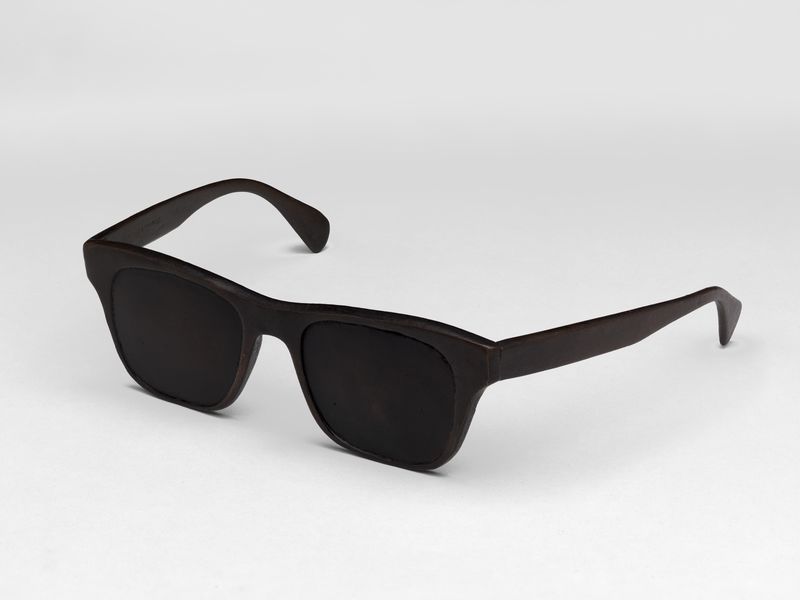
Mark Wallinger, Statue (Fragment), 2018
Mark Wallinger: There are a couple of reasons, also Hauser & Wirth’s bronze themed exhibition for which this was a latecomer. In Britain, the country is still rather littered with Victorian statuary of the great and good, and in recent times, in the absence of any very interesting public art, there are various campaigns at any point to have a bronze statue made of a significant figure. This is the first – and I would think and hope – the last bronze I ever make. I think bronze should have died as a reproductive material ‘round about when trousers came in. This show is about looking, it is about representation and it is about identity. And I like the paradoxical nature of the fact that if you cast a pair of spectacles then it renders them opaque and useless but it’s entitled statue, in brackets, fragments. So it has something of a kind of hubris, the notion that I might be worthy of a statue. But it also points to the fact that any statue of any short-sighted person like myself has this insurmountable problem of truth to materials.
DDS: Well you also said something to me about even the idea, statues that have glasses and how slightly bizarre they look in the end.
MW: The kind of ‘Bilko’ non-glasses, but it also references back as well to a character that was a trilogy of video works that I made in the nineties called ‘Speaking in Tongues.’ And I am this Blind Faith character wearing dark glasses and being overcome…
DDS: It's so interesting, this work if you know it, of Blind Faith and Mark. I think you have either a suit or just pants and white shirt, it's very simple and sort of finding your way. I'm just thinking as you're talking about that how much of this work is, in a way, about finding your way and then finding our respective ways through the world. That's why I thought it was so interesting to start with the glasses because you can't see through them, they're inert and they're heavy and the bronze makes that even more so – almost a kind of absurdity.
MW: I guess I'm working with reflection, illusion. It is very much about primary sense and I play on that optical instrument, and how consciousness is largely built around that.
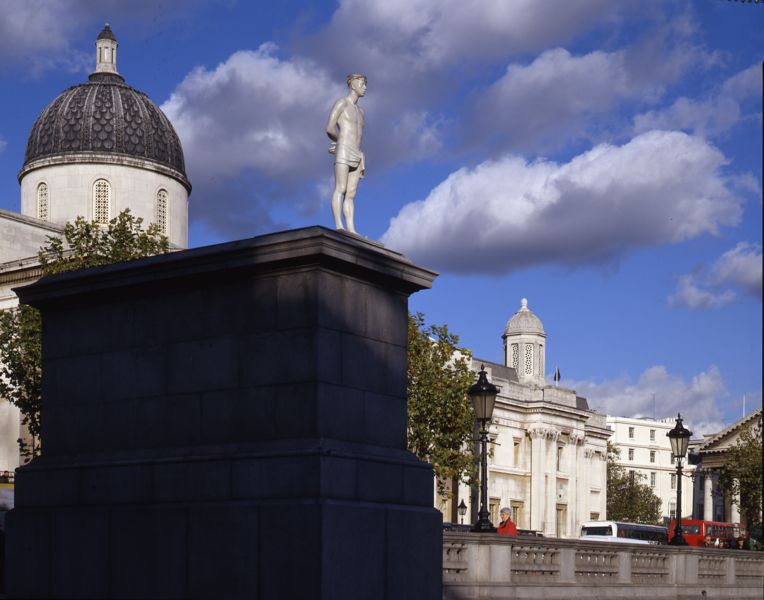
Mark Wallinger, Ecce Homo, 1999 – 2000. Installation View, Fourth Plinth, London, United Kingdom, 1999
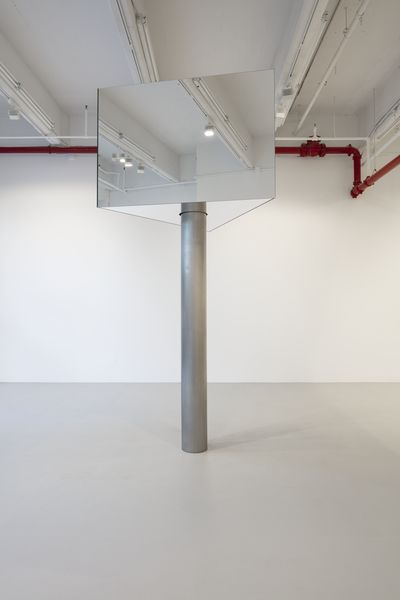
Mark Wallinger, Superego, 2018. Installation view, ‘Mark Wallinger. Study for Self Reflection’, Hauser & Wirth New York 22nd Street, 2018
DDS: The idea too even about the kind of vulnerability of going through the world not being able to see, and for those of you who may remember the empty plinth project that Mark did in London, it was actually the very first one and I still have such a visceral memory of going round Trafalgar Square and seeing this massive, empty plinth and then a statue, ‘Ecce Homo’ of Jesus Christ perched at the edge, but life size. And the tension between this plinth that was all about making something monumental and then the fragility, if you will, of that body which was human in the sense of at least what the implication was and the scale of it. This interest in statuary and interest in certain kinds of symbols that do have a history both in the history of art but also in talking about the ‘Superego’ piece. There's an interesting history about this piece that we discussed which really does have a specific reference in the UK, in London, and Scotland Yard – particularly the Metropolitan Police Department which I learned is the first police department in the world.
MW: Yeah, the first police force was the Metropolitan Police in 1829
DDS: Do you want to say a little something for those who don't know the source?
MW: This came about because I literally walked by it one day. The revelatory moment or noticing something or things from observation or experience are centrally important to my work – there's some kind of hook that grabs me at a certain point. I hope that enough of that in the making of the work is preserved, rather than just sitting down thinking ‘I'm gonna make something about so and so.’ This revolving sign has been the kind of logo of the Metropolitan Police since the 60s. This is a life size representation and it's revolving at the same speed. On the actual sign it just says Metropolitan Police New Scotland Yard, but it seemed to represent something about that notion of the police force as something vigilant, watchful…
DDS: All seeing.
MW: …all seeing, omniscient, all knowing. One can kind of feed into the dystopian or the utopian, but the thing that I liked as well is that it’s the shape of a prism. It looks like it's trying to say something about light but at the same time it's mirrored and we know that light travels at the same speed, whatever. But because we are not reflected back in these revolving sides it suggests a kind of all seeing, an overview somewhere beyond and I suppose in common with the little model for the Magna Carta Runnymede projects…
DDS: Right back there.
MW: Which we will get to later... Although they're very culturally specific to things in Britain, I think they have a reach beyond that, they are a point where concentric rings kind of reach further.
DDS: When I saw this piece, of course I knew that reference but also this kind of totem. I mean this structure to me could live in a variety of cultures. The Metropolitan Police may have done it but others did it as well, and so there is this sense unlike when you walk to the piece that was done in the Freud Museum, where we see ourselves reflected, we cannot see ourselves reflected here. So there is this sense of a kind of all seeing power. Living in London at the time I did, the CCTV was everywhere and now in the US it's far more than I think I can imagine even five years ago. So it has a kind of universal quality, this totemic figure and because it's stripped of any reference it's even more sinister, that's a real sinister quality to me.
MW: Yeah…
DDS: You know, in terms of the idea of watching us, it's watching us, we're watching...And when you go to some department stores, or when you go through customs at the airport and you have that window, the glass mirror and it’s as if somehow we don't know they're behind that looking at us but they are. And it makes me think so much how these structures of power for you of authority, of power, of displacement, have a tremendous relevance now.
MW: This show is called ‘Study for Self Reflection,’ so in a way as well I see it as kind of an exploded self portrait, but it's a kind of self that we can all recognize as well perhaps. This piece was made at the same that I was making the id Paintings and I made a work called ‘Ego.’ I was kind of purloining Freudian terms as well, and as much as the paintings that I was making at the time were very, very instinctive and kind of personal it required something from out there in the world that denotes something to take the part of the super ego.
DDS: This idea of the ‘Study for Self Reflection,’ which is very much about the notion of examining one's inner psyche, certainly through Freud and the construction of self, I think there's a lot of biographical references here which I think you can speak to. Then there's also this study, this notion of self-reflection that goes beyond. I mean the mirror obviously as something that we can see ourselves in, and even the alchemy of when mirrors were invented and the magic of seeing yourself in a mirror and a very mediating relationship to one's self.
MW: Alberti talks about art being nothing more than embracing one's reflection in a pool like Narcissus.
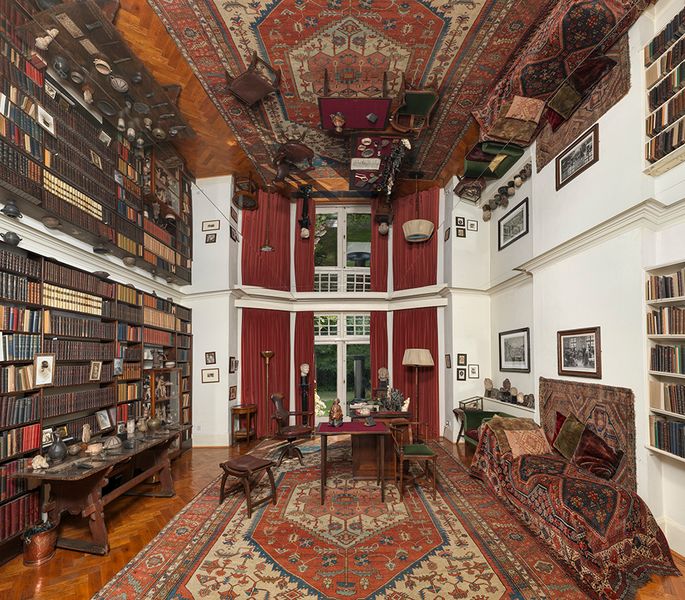
Mark Wallinger, Self Reflection, 2016. Installation view, ‘Mark Wallinger. Self Reflection’, Freud Museum, London, United Kingdom, 2018
DDS: I think next we are going to go to look at the mirror that is hanging from the ceiling that you can see your reflection in. This work, which is called ‘Self Reflection’ from 2016, was installed in the Freud Museum in London, if any of you have ever gone there. It's quite amazing because you see Freud’s couch on which he analyzed many people, and of course it's filled with all of Freud’s things. My understanding is this literally marks the actual perimeter of Freud’s study. Why don't you say, for those who don't know the context, a little bit more about how it even came about for you to do a project – this was once hung in Freud's study at the ceiling level. Can you talk about how that came about as a project initially, or an idea?
MW: The Freud Museum has a program in which it asks artists to create works for the building. I chose to mirror Freud's study's ceiling. The very particular thing about Freud's study is, of course, the family had to flee Vienna in '38, and he didn't really live for longer than a year when he moved to London. But every last object, antiques, statuary, all his books, and the famous couch, were crowded in into this room. In one sense, if you went to see Freud ... Someone said when I was installing, “You know, it's not really about you.” It's like you had the artifacts of the entirety of Western thought at his shoulder. What the mirror's ceiling did was effectively double the space and then reflect back with such clarity that a lot of people have said that the things in the mirror seemed crisper than in reality. I think what happens is it boggles the mind. What one's receiving back are empty photons: everything matches, except there's no weight or mass. It's the opposite of top lighting, as well, which is the other thing that we take for granted for securing us in the world. At the same time it obviously alludes to mirrored ceilings in other establishments perhaps… As the analysand you would be reclined, looking back at this. In an almost cartoon kind of way, I tend to think of the conscious mind and the unconscious as these two kinds of vessels; the one was mirroring the other. It interested me to then take this, which was the actual mirror that was used there, and to show it here at the same height and in the same coordinates, north, south, east, and west, but obviously, in the absence of everything that was there. I suppose, it speaks to what happened to the Freud family and another kind of displacement. At the same time, we are so familiar with these ideas that we can fill in.
DDS: Well, it is displaced. It's like a double displacement, because the piece was made for a site. It's been taken from that site. Now it's situated here, and the reference to Freud's family, and as a refugee, having to leave – obviously, something that's on all of our minds in many ways. I'm just curious when you first saw it here installed in the gallery and in a very different context, which in some ways – take this in the right way, but every artist, when they have an exhibition – is put on display. I mean it's really a moment where you are out there. It just hit me now, actually, in thinking about having something that's so pointed. What was your thinking in that, and what did you think when you first saw it installed in the white cube?
MW: Well, it reminded me a little bit of years ago, I tried to make a work in Cyprus. I was in Nicosia, and I crossed the Green Line into the Turkish side. There's the old cathedral building there. You enter the nave, but everything within it is repurposed on a diagonal heading towards Mecca, because it's now the Selimiye Mosque. I thought, ‘Was that in 1974 during the invasion?’ In fact, it was 1570. I couldn't help but think somehow it was related as well to my experience of going to Berggasse in Vienna and the apartment out of which Freud worked there, which is now empty of everything because it's in London. It's kind of about how systems of thought are transplanted around the world.

Mark Wallinger, Threshold to the Kingdom, 2000. Installation view, ‘MARK WALLINGER MARK’, Centro Pecci, Prato, Italy, 2018
DDS: Systems are, I've always felt, a big part of your work. Looking at systems of power, even of religion. I think of this amazing work called ‘Threshold to the Kingdom’ that you've made that is, I think, just an incredible work. To describe it to you, it's the international arrivals at which airport?
MW: London City Airport.
DDS: It's London City Airport, but if you saw it, you could be anywhere. It has this sort of generic feel. It's in a slow motion, and you're watching people as they come through the arrivals. The score is…?
MW: It's Allegri's Miserere.
DDS: So you have this extraordinary music, and you're watching these people. They come out, like if you were expecting someone to pick you up, or you're even hoping someone is there to greet you when you come out of the airport. People are just sort of looking around, but to call it ‘Threshold of the Kingdom,’ of course, brings in this very powerful religious symbolism to it. I've really not asked you about this whole interest in ‘Jesus Christ,’ or in ‘Threshold to the Kingdom.’ Even in ‘Angel,’ the great piece where Mark is at the bottom of the Tube Station on the escalator step and kind of walking in a somewhat Chaplinesque manner. Suddenly, it goes back up, and you ascend. It's quite a theme throughout so much of your work. Is that from childhood? What’s the story there, Mark?

Mark Wallinger, Angel, 1997
MW: Well, no. I think religion is the thing that's the dominant force in the world, to be perfectly honest… In ‘Angel’ I learned phonetically backwards the opening six verses of John's Gospel, ‘In the beginning was the Word…’ and Threshold to the Kingdom is a setting of the 51st psalm, which is a plea for forgiveness to a merciful God. And so ‘Threshold to the Kingdom’ is the United Kingdom or the Kingdom of Heaven, if you like. That was the pun. But it seemed to me that I could kind of examine what is this religion that I was born into, the established religion, Christianity? I felt I couldn't, in all honesty, make a work about Islam. But, by inference, I think there is something about a believing community (and perhaps the British in particular) who tend to think that they're the natural default mode and all these other kind of belief systems are the crazy ones. But we believe that we are ingesting the blood and body of Christ! By the same token, we were coming up to the millennium and no one in Britain seemed to have the – well the only word is bravery really – to say that we were 2000 years since the birth of Christ, so the Millennium Dome was created and the government went to Disneyland to see what to fill it with. So Christ seemed to be an important figure.
DDS: The Millennium Dome was quite a scandal in the end. It's still there. It's a kind of huge structure. If you come from the airport, inevitably you see it. These systems of belief and structures, and I want to get to this all-seeing eye, which is in some ways Freud as this sort of very symbolic figure on that level, and the kind of self-consciousness that comes with that. And then you’re looking at yourself, us looking at your work, us looking at ourselves. I mean, it's sort of reverberating on all these different levels. Tell me about, if you haven't looked, and now it's hard if you haven't seen it, but the image of Freud, who is actually behind that wall, behind the two peepholes, which I think you've called ‘Psycho?’
MW: It's somewhat, sort of provocatively called ‘Psycho.’ Psycho is obviously the prefix for Freud's profession, and about 200-odd other words, and also a well-known film… and also Etant Donnes, if you like, with the dual peepholes.
DDS: Duchampian reference
MW: Of the reason I made it… There's a famous photograph of Freud taken in 1921 by his son-in-law, Max Halberstadt. I discovered, looking through some archives, there were actually two extent photographs. You only need two photographs that are from slightly different viewpoints to be able to generate stereoscopy. So in peeping there you see Freud, but you see him in a third dimension. I like that idea because our ability to experience space is a function of stereoscopy, and the very way we are perceiving him is happening mysteriously inside here [MW indicates his own head] and is kind of an inexplicable part of consciousness.
DDS: There's also a slightly funny aspect of the photograph because of the stereoscopic. He has a cigar.
MW: Yeah, so cigars in two different positions that hover behind.
DDS: Slightly, it looks like he's flicking it, if I remember?
MW: Yeah.
DDS: I thought he looked slightly W.C. Fields.
MW: Right, right.
DDS: I think we're going to continue to the next room and look at the painting series that you've been involved with that are part of this as well. It was fascinating, actually, hearing you when we met earlier speak about the making of these Mirror paintings and the series of id Paintings that preceded them of your Rorschach paintings. I mean all of these are made with your fingers. No brush, right?
MW: Yeah.

Installation view, ‘Mark Wallinger. Study for Self Reflection’, Hauser & Wirth New York 22nd Street, 2018
DDS: When you look at them they have obviously this feeling of this monochrome, but then they're deeply inflected on a surface level and they're also quite distinct. You begin to see the differences. I'm curious, you're such a conceptual artist and then to take that painting here and what looks like a gestural painting, I think, is working in a very different way, a kind of recording of self. Can you talk a little bit about how this came about and even the actual making of them, because it's a performative act in a lot of ways.
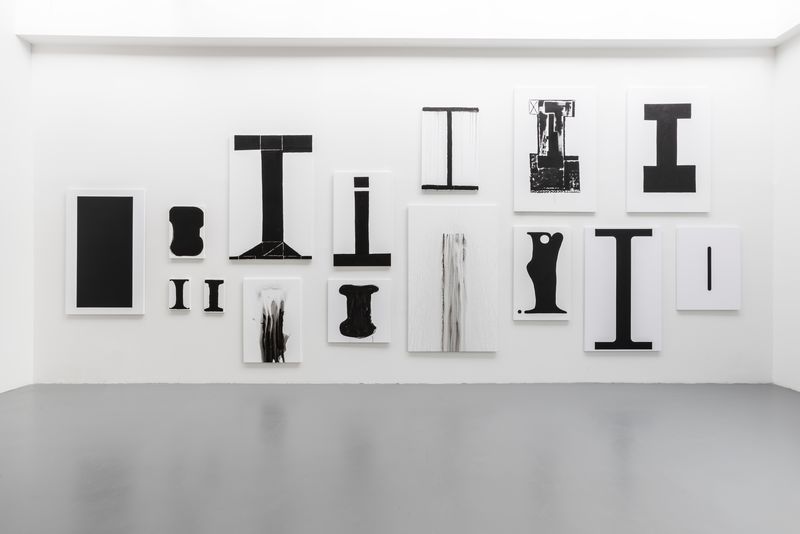
Installation view, ‘MARK WALLINGER MARK’, Centro Pecci, Prato, Italy, 2018
MW: Before the Mirror paintings I started making Self Portrait paintings using the capitalized letter ‘I,’ the word we have for ourselves that we share with everyone else and started by using known fonts for that because we live in this weird epistolary age. We have an instinct for fonts and the rest of it. I started doing ones that I kind of described to myself as freehand, and then that became something I pursued for the next few years, in between working on other things. I moved into a new tall factory space and thought, okay maybe we can push these to a more monumental scale. I had some stretchers made up that were to my span and double my height and worked on about ten paintings. I made a painting in which I used both my hands to create still this motif of the ‘I’ but very symmetrically. Halfway through working on it, I flipped the canvas up the other way and then that led to what I call the id paintings. I suddenly thought, well I've found a little kind of arena for expression. The hardest part about painting is that you've got the entire history of art bearing down on you and it's very hard to find a place where you're not in some kind of ironic or arch relationship with all that. Once I kind of dispensed with the brushes I realized I could achieve a kind of symmetry in these gestures, and then those gestures themselves both described a trace of an action and were an image as well. It's something in the symmetry rendered every mark significant just by dint of its reflection. So that carried me along for a while and then I moved through a sequence of what I call Action Paintings which were starting to use silver paint into black grounds and then the silver started taking over. I guess, whatever that symmetry in the id paintings was, maybe it moved 90 degrees so it was all about this surface and its shine and its bafflement and it is kind of monochrome. In a sense, every hand mark feels like it's met its partner beyond that surface.
DDS: These are very different than the paintings where you have this essential form and the Rorschach which really trace your body. It's the width of your body that you see here in this format. But then when you get to this you almost get lost because they’re so heavily worked as a surface that it’s almost impossible to see where it begins, where it ends. It’s obscured in this way and they’re so deeply layered. Even the idea of where they start from and, you'll see, it took me a while but I really encourage you to just look at them because they’re quite distinct in the read, the depth of the image, even the tonality is quite different one to the other. Knowing those paintings, the id paintings, and these tracings where there's a clarity of self and then this – Can you say a bit more about even the making of these, where did you start, where did you end?
MW: This was kind of almost like a kind a dancing activity across these two panels. I became fascinated in just what was a depiction, what was an erasure, what was expressed, what was repressed – there were levels of ambiguity. Also just working with this stuff, which has its own shine that you work on. It's fairly opaque white liquid but then dries to achieve this shine and it's, in a sense, just trying to eff the ineffable but it's also a fascination with this surface and this kind of space that it creates. I suppose the little Monet photograph is a sort of talismanic object; it’s the shadow of his head on one of the ponds at Giverny. Thinking about that impossible space which is so sustaining in the ‘Water Lilies,’ which is the reflected sky on the surface of a pond.
DDS: In the next room there's an amazing photograph of Monet of a painting with a shadow. This reflection of light, obviously Monet painting light, and the sense of reflection here is just so fundamental to the painting. It links up so many of the works here from the Freud work, to the seeing of the eyeglasses, because it's very intensely material. It's working with material and the properties of material in the way that you work with bronze or you worked with the reflectivity of the mirror. Was the Monet thing in your head, did you have a long-standing interest in Monet? How did that come about, because you've been making these series for a while but these are quite different than the earlier id Paintings?
MW: There was a blockbuster Monet and the garden at the exhibition in the Royal Academy a couple of years ago, and this little photograph was in a cabinet amongst a bunch of other catalogs and things like that. It's actually entitled ‘Self portrait’ and it's incredibly conceptual work in 1905 by this very famous painter and it has something of vanitas about it as well.
DDS: Yeah, it's very beautiful, a little poetic, but also enigmatic. The thing I thought when I first saw these paintings, and knowing the earlier series, is how enigmatic they are. It becomes impossible to really figure out, even the tracing of the hand. The gestures are so woven together that it becomes impossible, there are moments where you see almost what looks like a hand print or you can see fingers – which is you. I mean it's your body making the impression but it's not as if you could pull out any one of those things in that way. There's something to me about the obscuring of self, the enigmatic, the impenetrability of surface; as much as we look at the mirror, you can never penetrate it. It throws back on you at the end of the day. Looking at your work I think of you, obviously; when I know an artist it's always a different relationship. But I think there's something that goes way beyond you that is a human condition, in many ways is a kind of struggle of seeing and not seeing - of the glasses that are dark, that are black, that you can't see through. Maybe we all struggle with this as human beings and I just think these paintings, are really extraordinary and, for knowing your work, it's a kind of breakthrough. It moves past some of the paintings you were making earlier. I like those as well, but at the same time, there's something here that seems so united with the other work. I think we're going to wrap it up. Are there questions from anyone? You're not obligated but this is your opportunity, if you want to just luxuriate in the work that's okay as well.
Audience member: I just wanted to make the comment I said to Mark before the evening began: there's a certain ephemeral and ethereal quality to everything. What's so interesting is you are confronted by the mirrors, and the glasses, and then you see that tiny photograph of Monet and then you're here. The progression is very beautiful and sort of leaves you asking a lot of questions.
DDS: I think that idea of the ephemeral, the sublime, and yet the photographic which does always has a sense of being evidentiary. It's evidence but evidence of what?
MW: Silver from gelatin silver to silver mirroring, to the paintings is the unifying thing as well.
DDS: It's the alchemy. It's the kind of magic.
‘Mark Wallinger. Study for Self Reflection’ is on view at Hauser & Wirth New York, 22nd Street from 13 September – 27 October 2018.
